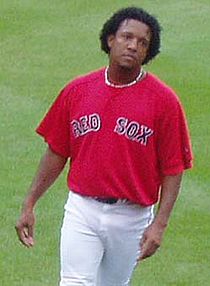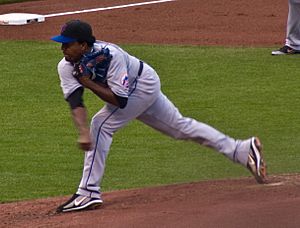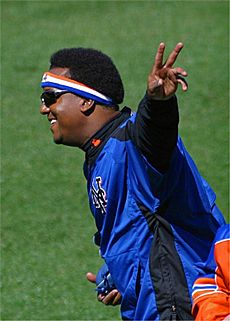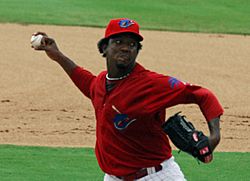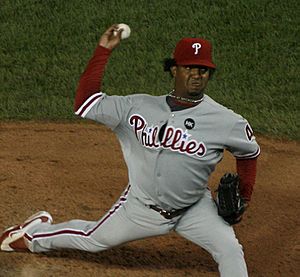Pedro Martínez facts for kids
Quick facts for kids Pedro Martínez |
|||
|---|---|---|---|

Martínez in 2010
|
|||
| Pitcher | |||
| Born: October 25, 1971 Manoguayabo, Dominican Republic |
|||
|
|||
| debut | |||
| September 24, 1992, for the Los Angeles Dodgers | |||
| Last appearance | |||
| September 30, 2009, for the Philadelphia Phillies | |||
| MLB statistics | |||
| Win–loss record | 219–100 | ||
| Earned run average | 2.93 | ||
| Strikeouts | 3,154 | ||
| Teams | |||
|
|||
| Career highlights and awards | |||
|
|||
| Induction | 2015 | ||
| Vote | 91.1% (first ballot) | ||
Pedro Jaime Martínez (born October 25, 1971) is a Dominican-American former professional baseball starting pitcher. He played in Major League Baseball (MLB) from 1992 to 2009. He is best known for his time with the Boston Red Sox from 1998 to 2004.
Pedro Martínez has one of the best winning records in baseball history. He won 219 games and lost only 100. He also had a super low ERA (Earned Run Average) of 2.93. This shows how few runs he let opponents score. He reached the 3,000 strikeout mark faster than almost any other pitcher. He is one of the few pitchers to have more strikeouts than innings pitched. Pedro also struck out a lot of batters per nine innings, ranking among the best ever.
An amazing eight-time All-Star, Pedro was one of the most dominant pitchers ever from 1997 to 2003. He won the Cy Young Award (given to the best pitcher) three times. He was also close to winning it two other times. During this time, he had an incredible record of 118 wins and only 36 losses. He led his league in ERA five times and in wins and strikeouts three times each. In 1999, he won the pitching Triple Crown. This means he led the league in wins, ERA, and strikeouts. He also became one of the few pitchers to win the Cy Young Award in both the American League and National League.
Pedro was officially listed at 5 feet 11 inches tall and 170 pounds. This was quite small for a modern power pitcher. Later in his career, injuries started to affect his play. His performance dropped in his final seasons. Many experts today consider Pedro Martínez one of the greatest pitchers in baseball history. He was voted into the Baseball Hall of Fame in 2015. He was the second Dominican player to receive this honor. The Red Sox retired his number 45 jersey two days after his Hall of Fame induction.
Contents
Early Life and Baseball Dreams
Pedro Martínez grew up in Manoguayabo, a suburb of Santo Domingo in the Dominican Republic. He was one of six children. His family lived in a simple house with a tin roof and dirt floors. His father, Pablo Jaime Abreu, worked many different jobs. His mother, Leopoldina Martínez, washed clothes for wealthy families. When Pedro was old enough, he worked as a mechanic.
He did not have enough money to buy baseballs. So, he practiced pitching with oranges instead. His older brother, Ramón Martínez, was a pitcher for the Los Angeles Dodgers. Ramón was at a baseball camp in the Dominican Republic. As a teenager, Pedro carried his brother's bags at the camp. One day, Ramón measured his 14-year-old brother's pitches. They were already between 78 and 80 miles per hour!
Pedro started playing professionally in the Dominican Winter League in 1989. He played for the Tigres del Licey.
Professional Baseball Career
Starting with the Dodgers
The Dodgers signed Pedro as a young player in 1988. In his first minor league season, he worked with coach Guy Conti. Conti taught him a special pitch called a "circle changeup." Conti also helped Pedro learn English and get used to life in the United States. Pedro later called Conti his "white daddy."
Pedro made his MLB debut on September 24, 1992. He pitched two innings for the Dodgers against the Cincinnati Reds. He made his first start on September 30, but his team lost.
Even though Pedro's brother Ramón said Pedro was an even better pitcher, the Dodgers manager, Tommy Lasorda, thought Pedro was too small. He believed Pedro couldn't be a good starting pitcher in MLB. So, Lasorda mostly used Pedro as a relief pitcher. In 1993, Pedro had a strong season as a relief pitcher. He won 10 games and lost 5, with a 2.61 ERA. He also had 119 strikeouts in 65 games. The Dodgers needed a second baseman, so they traded Pedro to the Montreal Expos before the 1994 season.
Becoming a Star with the Expos
Pedro Martínez truly became one of baseball's best pitchers with the Expos. He had a very fast fastball, but sometimes struggled with control. His manager, Felipe Alou, told him to change how he held his fastball. This change made a huge difference. His fastball became incredibly accurate and hard to hit.
On April 13, 1994, Pedro was pitching a perfect game (no one had reached base) through seven innings. He then hit a batter, Reggie Sanders, with a pitch. Sanders got angry and charged the mound, starting a fight. Pedro ended up not getting the win in that game.
On June 3, 1995, Pedro pitched nine perfect innings against the San Diego Padres. The score was still 0–0, so the game went into extra innings. In the 10th inning, he gave up a hit and was taken out of the game. He still got the win, but it wasn't an official perfect game because he didn't finish the game perfectly.
In 1997, Pedro had an amazing season for the Expos. He won 17 games and lost 8. He led the league in many pitching stats, including a 1.90 ERA and 305 strikeouts. He also pitched 13 complete games (meaning he pitched the whole game himself). He was the only Expo player to ever win the National League Cy Young Award. He was also the first right-handed pitcher since 1912 to have 300 strikeouts with an ERA under 2.00.
Dominating with the Boston Red Sox
Before he could become a free agent, Pedro was traded to the Boston Red Sox in November 1997. The Red Sox then signed him to a huge contract. Pedro quickly showed he was worth it. In 1998, he won 19 games and lost 7. He finished second in the American League for ERA, WHIP (Walks plus Hits per Inning Pitched), and strikeouts. He also came in second for the Cy Young Award.
In 1999, Pedro had an even better season. He won 23 games and lost only 4, with a 2.07 ERA and 313 strikeouts. He won the Pitching Triple Crown. He also led the league in strikeouts per nine innings and strikeout-to-walk ratio. His FIP (Fielding Independent Pitching), which measures a pitcher's skill without relying on defense, was the lowest since 1910. He became only the ninth pitcher to have two seasons with 300 or more strikeouts. Pedro was also the only pitcher in the 1900s under six feet tall to get 300 strikeouts in a season.
Pedro won his second Cy Young Award without any opposing votes. He also finished second in the AL Most Valuable Player (MVP) voting. Some people thought he should have won MVP, but two sportswriters didn't vote for him. They believed pitchers shouldn't win MVP because they have their own award, the Cy Young.
From April to May 1999, Pedro struck out 10 or more batters in seven games in a row. He did it again for 10 games in a row between August 1999 and April 2000. In 1999, he struck out batters in 40 innings in a row, which was a record at the time. Pedro had 15 or more strikeouts in a game 10 times in his career. This is tied for the third most in history.
Pedro was named the AL Pitcher of the Month four times in 1999. He showed how dominant he was in the 1999 All-Star Game at Fenway Park. He struck out five National League stars in just two innings. He was named the All-Star Game MVP. He was the first pitcher to strike out the first four batters in an All-Star Game.
Pedro was a key player in Boston's 1999 playoff series against the Cleveland Indians. In Game 1, he had to leave early due to a back injury. But in Game 5, with the series tied, Pedro came in as a relief pitcher even though he was injured. He pitched six innings without allowing any hits. The Red Sox won the game and the series. In the American League Championship Series, Pedro pitched seven shutout innings against the New York Yankees. This was the only loss for the Yankees in their 1999 postseason.
Pedro had another amazing season in 2000, winning his third Cy Young Award. His ERA of 1.74 was the lowest in the American League since 1978. His ERA was much lower than any other pitcher's that year. Pedro won 18 games and lost 6. In his six losses, he still pitched very well. He had a 1.0 ERA in games where his team scored two runs or less.
Pedro's WHIP in 2000 was 0.74, the second lowest in MLB history. He struck out 284 batters and only walked 32. This broke his own record for the best strikeout-to-walk ratio in AL history. He allowed only 128 hits all season. Many baseball experts believe Pedro's performance during 1999 and 2000 was the best ever for any pitcher. He pitched during the "Steroid Era," when batters were very strong. He also pitched in Fenway Park, which is known for being easy for hitters.
Pedro had injuries in 2001, but still pitched well when he played. In 2002, he was healthy again and led the league with a 2.26 ERA, 0.923 WHIP, and 239 strikeouts. He won 20 games and lost 4. However, he narrowly lost the Cy Young Award that year. In 2003, Pedro won 14 games and lost 4. He led the league in ERA, ERA+, and WHIP for the fifth time.
In 2004, Pedro had a higher ERA than usual, but still won 16 games and lost 9. He was second in the AL in strikeouts. The Red Sox made the playoffs. Pedro pitched well in the playoffs. He helped the Red Sox win the 2004 World Series in four games. This was their first championship in 86 years!
Pedro finished his Red Sox career with an amazing record of 117 wins and 37 losses. His winning percentage was .760. He had a 2.52 ERA and 1683 strikeouts. He finished in the top four for the Cy Young Award in six of his seven years in Boston, winning it twice.
Time with the New York Mets
After winning the World Series in 2004, Pedro became a free agent. He signed a four-year contract with the New York Mets. In 2005, his first season with the Mets, Pedro won 15 games and lost 8. He had a 2.82 ERA and 208 strikeouts. He also led the league with a 0.95 WHIP.
Pedro started the 2006 season very strong. But in May, he injured his hip. This injury affected the rest of his season. He later had surgery for a torn muscle in his left calf and a torn rotator cuff. This kept him out for most of the 2007 season.
On September 3, 2007, Pedro returned from his injury. He won his 207th career game. He also got his 3,000th career strikeout, becoming the 15th pitcher to reach this milestone. Pedro became only the fourth pitcher to reach 3,000 strikeouts with fewer than 1,000 walks. He was also the first Latin American pitcher to get 3,000 strikeouts.
His strong finish in 2007 gave fans hope. But 2008 was a tough year for Pedro. He got injured in his first game of the season. He finished the year with a losing record for the first time in his career. His ERA and WHIP were also the highest they had ever been. During his four years with the Mets, Pedro won 32 games and lost 23.
Playing for the Philadelphia Phillies
Pedro was a free agent after 2008 and didn't sign with a team right away. In March 2009, he played for the Dominican Republic in the 2009 World Baseball Classic. He pitched well, but still didn't get an MLB contract. In July 2009, the Philadelphia Phillies watched him pitch. They then signed him to a one-year contract. Pedro told reporters he just wanted to be a "backup" pitcher.
Pedro joined the Phillies' starting rotation on August 12, 2009, and won his first game. On September 3, he won his 100th game as a National League pitcher. This made him the 10th pitcher in history to win at least 100 games in both leagues. The Phillies won each of Pedro's first seven starts.
Pedro pitched well in the NLCS against the Los Angeles Dodgers. He pitched seven shutout innings. He then pitched in Game 2 of the 2009 World Series against the New York Yankees. Pedro pitched effectively but took the loss. In his second start of the Series, Pedro called himself and opposing pitcher Andy Pettitte "old goats." He also said Red Sox fans were rooting for him. However, Pedro allowed four runs, and the Phillies lost the World Series to the Yankees.
After the Series, Pedro said he didn't plan to retire. But he didn't sign with a team in 2010. In December 2011, he officially announced his retirement. In December 2009, Sports Illustrated named Pedro one of the five pitchers on their MLB All-Decade Team. In 2011, the Smithsonian's National Portrait Gallery added a painting of Pedro to its collection.
After Retirement
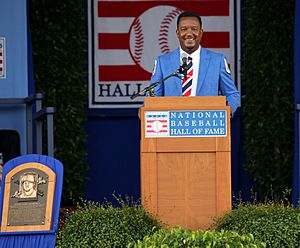
On January 24, 2013, Pedro joined the Boston Red Sox as a special assistant to the general manager.
Pedro was elected to the National Baseball Hall of Fame in January 2015. He received 91.1% of the votes. His Hall of Fame plaque shows him wearing a Boston Red Sox cap. Pedro said he was very proud to represent Boston in the Hall of Fame.
Pedro has worked as a baseball analyst for MLB on TBS since 2013. He also works for the MLB Network since 2015. In 2015, he released his autobiography, Pedro. He said that Barry Bonds, Edgar Martínez, Derek Jeter, Kenny Lofton, and Ichiro Suzuki were the toughest hitters he faced. Many other All-Stars also said Pedro was the toughest pitcher they ever faced.
On June 22, 2015, the Red Sox announced they would retire Pedro's number 45 jersey. This happened on July 28, two days after his Hall of Fame induction.
Memorable Games and Moments
The Imperfect Hit-by-Pitch
On April 13, 1994, Pedro was pitching a perfect game for the Montreal Expos. In the eighth inning, he hit Reggie Sanders with a pitch. Sanders got angry and charged the mound, starting a fight. Pedro ended up not getting the win.
Nine Perfect Innings
On June 3, 1995, Pedro pitched nine perfect innings against the San Diego Padres. No one reached base. But the game was still tied 0–0. In the 10th inning, he gave up a hit and was taken out. He got the win, but it wasn't an official perfect game.
All-Star Strikeout Show
Pedro was the starting pitcher for the American League All-Star team in 1999. The game was at Fenway Park, his home field. Pedro struck out Barry Larkin, Larry Walker, and Sammy Sosa in the first inning. He then struck out Mark McGwire to start the second. He was the first pitcher to strike out the first four batters in an All-Star game.
Yankee Stadium One-Hitter
Pedro almost pitched a perfect game again on September 10, 1999. He beat the New York Yankees, 3–1. He struck out 17 batters and walked none. Only a solo home run by Chili Davis in the second inning stopped him from a no-hitter. Pedro retired the last 22 batters he faced in a row.
Playoff Heroics
On October 11, 1999, in Game 5 of the ALDS, Pedro came into the game as a relief pitcher. He had a back injury. But he pitched six innings without allowing any hits. The Red Sox won the game and the series.
In Game 3 of the ALCS, Pedro faced Roger Clemens. Pedro struck out 12 Yankees in seven innings. He allowed only two hits. The Red Sox won 13–1. Pedro helped the Red Sox give the Yankees their only loss of the 1999 postseason.
Another Close Call
On August 29, 2000, Pedro had a no-hitter going into the 9th inning against the Tampa Bay Devil Rays. He lost it on a single by John Flaherty. Pedro had started the game by hitting the first batter, Gerald Williams. Williams charged the mound and knocked Pedro down. Pedro then retired the next 24 batters in a row. He finished with a one-hitter.
Pedro vs. Zimmer
In a tense Game 3 of the 2003 ALCS, Pedro hit Yankees player Karim García with a pitch. This caused a shouting match. Later, during a fight on the field, 72-year-old Yankees coach Don Zimmer ran towards Pedro. Pedro grabbed Zimmer's head and threw him to the ground. Pedro later said he regretted the incident.
Grady Little's Visit
Pedro was pitching in Game 7 of the 2003 ALCS against the Yankees. The Red Sox were ahead 5–2 in the 8th inning. Pedro was getting tired. His manager, Grady Little, visited him on the mound but left him in the game. This was a very controversial decision. The Yankees tied the score against Pedro. They then won the game in extra innings, ending the Red Sox's season.
World Series Debut
In 2004, Pedro got the win in Game 3 of the 2004 World Series. He pitched seven shutout innings against the St. Louis Cardinals. This was his last game for Boston.
Return to Fenway
In June 2006, Pedro returned to Fenway Park to play against the Red Sox. It was his first time playing there since leaving the team. The Red Sox showed him a video tribute. But Pedro had his worst game as a Met, giving up eight runs. This was his only career game against the Red Sox, and he never got a win against them.
Who's Your Daddy?
In both the 2004 ALCS and the 2009 World Series, New York Yankees fans would chant "Who's your daddy?" when Pedro was pitching. This was because he once said, "I mean what can I say? Just tip my hat and call the Yankees my daddy."
Pedro's Pitching Style
Pedro Martínez had amazing pitches. His four-seam fastball, power curveball, cutter, sinker, and circle changeup were all excellent. He also had incredible control over his pitches. This made him very hard to hit. Pedro threw from a low angle, which made it hard for batters to see the ball coming. He also threw three different types of fastballs, each with perfect control.
Early in his career, Pedro's fastball was very fast, usually around 95–98 miles per hour. He used it with his amazing changeup and curveball. Many experts say that no pitcher in baseball history was more dominant than young Pedro.
As he got older and had injuries, Pedro learned to rely more on skill than just power. His fastball became a bit slower, around 85–88 miles per hour. But he still used his curveball, changeup, and slider. Because he had such great control, he remained a very effective strikeout pitcher. Baseball historian Bill James said Pedro was much better than other pitchers because of his many different pitches, speeds, perfect control, and ways of tricking batters.
Pedro's Personal Life
Pedro is married to Carolina Cruz de Martínez. She used to be a reporter for ESPN Deportes. Now, she runs his charity, the Pedro Martínez and Brothers Foundation. Pedro has four children. One of his sons, Pedro Martínez Jr., signed with the Detroit Tigers in 2017. Another son, Pedro Isaías Martínez, plays college baseball. Pedro also has a son named Enyol and a daughter named Nayla. Pedro became an American citizen in 2006.
See also
 In Spanish: Pedro Martínez para niños
In Spanish: Pedro Martínez para niños
- Major League Baseball titles leaders
- List of Major League Baseball annual ERA leaders
- List of Major League Baseball annual strikeout leaders
- List of Major League Baseball annual wins leaders
- List of Major League Baseball career strikeout leaders
- List of Major League Baseball career wins leaders


